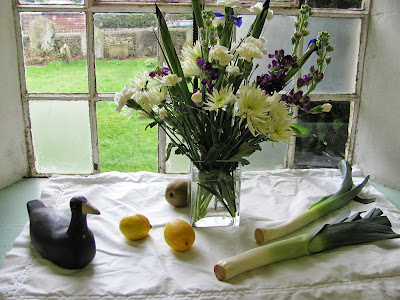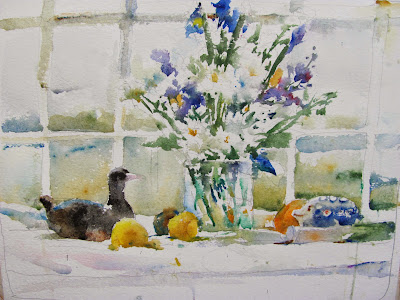Wednesday dawned, a thoroughly miserable damp and cold day, quite a contrast from Tuesday, but as we were indoors and the hall was well heated this wasn't a problem. The subject was Charles trademark combination Flowers/Still Life.
Guess Who!
Charles Craig Young palette. Note the small amounts of paint and his latest addition Cobalt Violet, in the bottom right position. His two greens are Oxide of Chromium and Viridian but he also mentioned Cobalt Green Dark and you can see two shades in the third pan across, second row down. Charles also talked about only putting out sufficient paint needed as it must be fresh, nice and juicy, so that the tip of the brush digs into it. Sometimes he mixes on the palette, quite often straight from paint well to paper. As for makes he mentioned Winsor & Newton but had many tubes of Holbein, his long time choice, in his box.
Charles started with a quite complicated drawing using on this occasion some Schut very rough paper. He draws lightly, using a mechanical pencil, and when painting will improvise. Mostly he uses Fabriano Artistico paper, although he likes Schut Noblesse, which isn't generally available. The Schut rough he used - I'm not sure what it is called - is very rough and can give a different effect, although not the easiest to paint on. He also likes the Czech Moldau hand made paper.
This was the subject and Charles spends some time moving things around, both flowers and objects until he gets them exactly where wanted.
Checking its just right.
The completed drawing.
When he started painting he usually starts at the rim of the receptacle and likes to let paints work together, with a quite complicated interaction between the green leaves and flowers. He paints shapes rather than things and connects stems when the flowers are still wet.
The flowers are painted first - shapes not things. Value is more important than colour. You will note that he likes to have a flower(s) in the lower position rather than a mass of green leaves as in the actual composition. Apparently he particularly likes to paint white flowers, not everyone's favourite colour.
He starts adding the window frames and said you must vary the colour. He added some background, painting around the window frame. Avoid `mushy' colour apart from shadows. The darks are incorporated as he paints - no adding later. Timing is important as if too wet you can get a mess.
Almost there!
The finished painting a typical Charles Reid speciality, with many at this workshop particularly interested in this part of his repertoire. As usual Charles takes regular breaks - every 20 minutes or so - and goes outside to smoke his pipe. I noticed on more than one occasion clouds of smoke emanating from it! Probably contemplating a tricky bit. Charles is very communicative when painting, only occasionally going quiet when he needs to especially concentrate on a particular section. Part of the reason for the breaks is to let parts of the painting dry before pressing on. It isn't all wet-into-wet. He is actually quite pragmatic in his approach.
Together with the subject Charles painted, four other still life's - all with the same basic flower theme - were set up for the students afternoon painting session. groups of three to four congregating around each one. Charles circulated and commented on work in progress, while helping those who asked for assistance.
One thing I've missed is the critique, which took place at around noon or a little earlier after Charles had finished his demonstration. Each student was asked to submit one painting which Charles would then comment on. In my case I submitted the painting of Chris at the Stow Lodge Hotel. I mentioned earlier Charles made one basic criticism that the tree looked out of place and, the painting would be better without it - also the tree colours were too cool - the rest being okay.
The afternoon finished at around 4.30pm and all headed for their hotels, most thoroughly exhausted, or in my case a 20 mile car journey to my sister at Ducklington. Exhausted? After such intense concentration you usually are. Charles commented earlier that a two and a half hour session was enough for him during a day, and he found it hard to understand how some artists painted all day.











14 comments:
Terrific coverage Peter, felt as if i was present on the day. Classic Charles' work. That was interesting about the palette - get rid of old paint it seems. Thank you Peter.
Hi Peter,
I'm a big fan of Charles and consider him to be my greatest watercolour influence. Thank you for sharing your Charles Reid experience with us.
David
meldrum.blogspot.com
Thanks Ray. It is quite an undertaking and to know it is appreciated is welcome.
Thanks for commenting David. I'm pretty busy at the moment with these posts but will soon have a look at your blog.
Great description Peter. I too really appreciate these posts - maybe I could reward you with some Daniel Smith paint from the US? Are they cheaper here?
I always like Charles' white flowers. I love the way he has the stark tonal contrast between the petals and the surrounding leaves and then some very close tones to give the flowers form.
Thanks for your comments and offer Michele but I don't need nor seek any reward. There are a large number of artists,who would like to go on a Charles Reid workshop, who for one reason or another aren't able to do so. I hope by doing these posts they can get a flavour of what the workshops are like.
Quite right about Charles white flowers - he paints around them.
It really is like being there. Thank you for this fascinating post
A great running commentary throughout the three days. Glad you had a great time
Thanks for your kind comments Polly.
Thanks for comments Yvonne.
Schut is a Dutch watercolor brand, the factory makes paper since 1618. he rough paper is called Schut Flamboyant, it is really rough, but soft, its strange paper to paint on! I have a block that is at least 20 years old, and still good! Back then it was even rougher texture! More round holes! Last November 2014 I did visit the factory, and it was a nice experience! I can tell Noblesse is my favorite too! Its whiter then most 100% rag papers, and the sizing is gelatin based, so your washes dry smoother! regards Edo
Thanks Edo. I have used Schut, both Noblesse and another called Vivace. Liked them both but almost impossible to get in uk.
Thanks so much for this Peter. Although you posted it a while ago, the information is of course perennial. I always go back to Mr Reid's work when I feel stuck in my painting and try to find the humility to start again, right at the beginning. So helpful to know he took breaks every 20 minutes or so and that a short but intense painting session in a day is 'enough'. Hallelujah! Lightbulb moment for me. Thanks again.
Thanks Tanja
Post a Comment